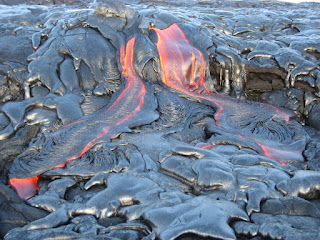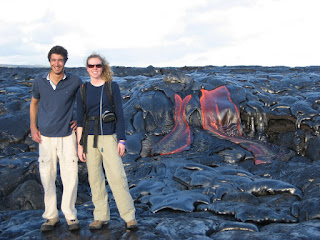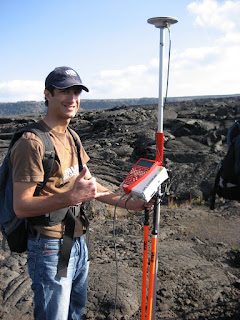At the end of last week, Andy, Jamal, Emma and I went in to Kilauea caldera to take GPS measurements of elevation changes in the caldera. It was the final training session for Jamal and I to learn how to use the Leica GPS unit and process the data with Leica Geo Office before Andy returned to London. The GPS unit is rather awkward to carry plus a 10 lb battery - makes for quite a sweaty excursion. The Observatory threw a little party for Andy at the end of the week and we took him out for breakfast on Sunday at the Volcano House breakfast buffet.
This week Jamal and I made the official decision on which project we wanted. Jamal is point man on a GPS project to record elevation measurements on the floor of Mokuaveoveo (caldera of Mauna Loa) and I am taking the lead on mapping an explosive fan deposit at the summit of Mauna Loa. The better part of my week was spent reading the user manuals for ArcView GIS, ArcPad and DNR Gamin and familiarizing myself with the programs. On ArcView I am making maps of my work area using GridMaker and topographic maps. The field area is 1x1 kilometers and I divided it in to 20 m sided squares. At each corner of a square plus the point in the middle I will be taking data within a 1 meter radius. The data I am collecting includes number of explosive rocks, types of explosive rocks and size of the 3 largest rocks. Explosive deposits include 5 types: ponded lava, weathered ponded lava, vesicular pahoehoe, weathered red pahoehoe and gabbro. The size of the 3 largest rocks are recorded to determine the energy required to project them that far and hopefully the mechanism behind the eruption. Using an Advantech CE device (hand held computer) loaded with ArcPad, I have created a table to imput data directly while in the field. The DNR Gamin is a hand held GPS device that has the grid points loaded in to it and can take me directly to the coordinates. Jamal and Kelly will be helping me in the field and be using their own GPS device but have to record the data with paper and pencil.
The only car capable of driving us up to Mauna Loa is a manual transmission, so this week Jamal and I had our first lesson on a 2002 Blazer around the Kilauea caldera. It was a rather jerky ride plus some stalling incidents for the both of us, but we managed without incident (except for that chicken I almost plowed over). That same day Emma took us with her on her gas sampling trip. We hiked 20 minutes to the western part of the Kilauea caldera along the rim of Halemaumau. She measures the carbon dioxide levels of fumaroles as well as the temperature of the steam and the water level. It was a particularly stinky afternoon, so during most of our hike we wore our gas masks. The temperature in the fumaroles was around 91 C and fogged up my sunglasses while I was taking samples.
Today (Sunday) Emma and I went on a 4 mile hike around Kilauea Iki caldera. In 1959 a half mile fissure erupted along the caldera wall of Kilauea. It erupted for 5 weeks from 17 different vents and created an isolated lava lake - a total of 86 million tons of lava. The lava was 2200 F and the hottest lava ever measured on the volcano. When lava drained from the caldera, the surface of the lake dropped 50' and created a "bath tub ring" around the edge. Steam still rises out of the caldera and deposits calcium sulfates and silica on the floor. A tumulus forms when pressure/magma beneath the crust pushes up and forces the crust to pop like a bubble.

Jungle walk at the beginning. Don't walk off the path because crevasses and steam vents are hiding in the vegetation.

Pu`u Puai, main vent for the eruption.

Basalt with olivine crystals! Green mineral in the bottom left.

Tumulus! Don't want to be standing on that when it popped!

Steam vents makes the caldera look as if it just cooled.
On the lighter side of life, we took a trip in to Hilo on Saturday for a sushi lunch and explored the Japanese garden located in the bay. The local grocery store, KTA, has delicious poke - raw fish, usually marlin or tuna, marinated in a variety of flavors. I recently purchased black bean marlin and it is chewy and spicy snack. Another volunteer house is populated by students from a school in Germany and they had a gathering on Saturday evening. A dance party broke out and Tyler and I showed off our famous fishing dance plus our newly minted one - flossing.
Next week: Jamal, Kelly and I spend 2 nights at the summit of Mauna Loa. Below freezing evenings, sleeping on uneven lava, spectacular star views, precooked food and our first attempt at taking data!
 Akaka Falls ~ 800'
Akaka Falls ~ 800'




















